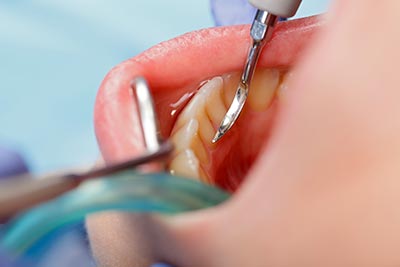Causes & Effect
 What Causes Periodontal Disease?
What Causes Periodontal Disease?
The primary cause of Periodontal disease is active bacteria living inside of dental plaque. In an effort to get rid of the bacteria, the cells of your immune system release substances that inflame and can damage the gums, periodontal ligament or alveolar bone. This generally leads to swollen and bleeding gums, which is a sign of gingivitis. Gingivitis is the earliest stage of periodontal disease.
What is Plaque?
Plaque is the extremely sticky substance that forms on your teeth very soon after you have just finished brushing. The buildup of plaque below the gum-line can cause your gums to become inflamed. Removing plaque promptly is important because if you do not, it becomes hardened or calcified over time turning into what is called “calculus”. Calculus is commonly called “tartar”. Calculus and plaque build up in layers. By not removing the tartar, even more plaque attaches to calculus because it is a rougher surface than tooth enamel. It is also rougher than cementum, the layer that covers the tooth root itself.
What is Periodontitis?
Damage from periodontal disease also can cause your teeth to become loose. This is a sign of severe periodontitis. Periodontitis is the advanced stage of periodontal disease when it has spread to below the gum-line. As the gums swell from the ever-increasing plaque bacteria, they detach from the tooth. This process forms a space or “pocket” between the tooth and gum. Bacteria can grow rapidly in these pockets. This encourages further plaque buildup.
How do you prevent Periodontal Disease?
You can prevent periodontal disease by practicing good oral hygiene and visiting your periodontist regularly. It is recommended that you should see the periodontist about once every six months. But if you already have gum disease (or periodontitis) you may need to visit them more often.
By brushing your teeth daily and flossing regularly (when done correctly), it can help to remove most of the plaque from your teeth. Professional cleanings by your periodontist will help to keep the plaque under control in those hard-to-reach places that toothbrushes and floss just cannot reach.
If your oral hygiene regimen slips or you skip your periodontal visits, plaque will continue to build up on the teeth. Eventually, it will spread to below the gum line. Once this occurs, the bacteria become protected, simply because your toothbrush can’t reach it. If plaque is not removed at this stage, the bacteria will naturally continue to multiply. As a result, your gum inflammation may get worse!
If left untreated, periodontal disease may destroy the periodontal ligament and the alveolar bone. These are the very structures that support your teeth.
Using a tartar-control toothpaste may help slow the build-up of calculus around your teeth. However, it can’t affect the tartar that has already formed below the gum line.
At South Calgary Periodontal, we can help show you how take care of your teeth – as part of a healthy lifestyle – so you will have a smile that can last a lifetime.
At South Calgary Periodontal Group, we are always welcoming new patients.
Call us at (403) 278-5446 to book your Periodontal consultation appointment today!
